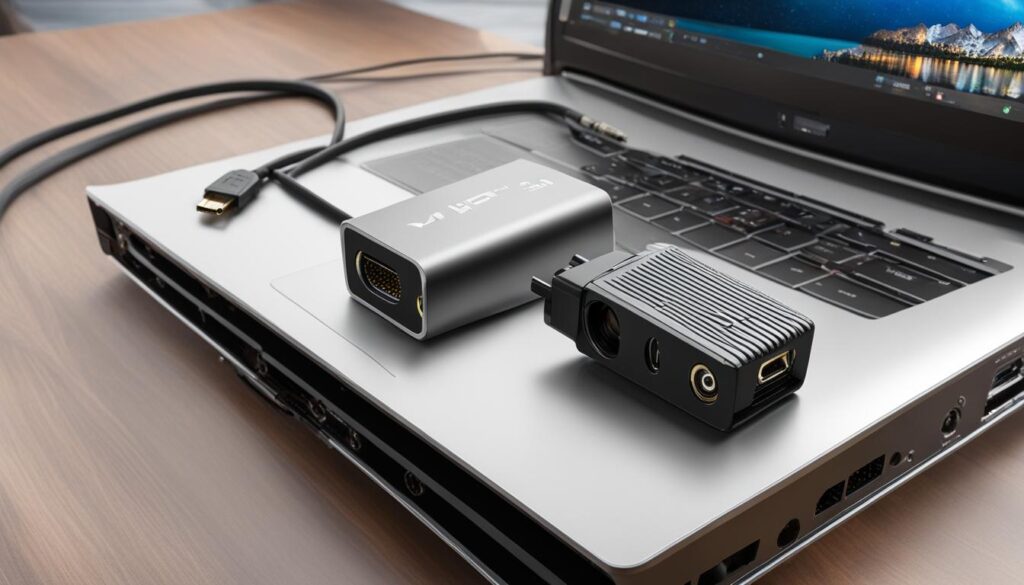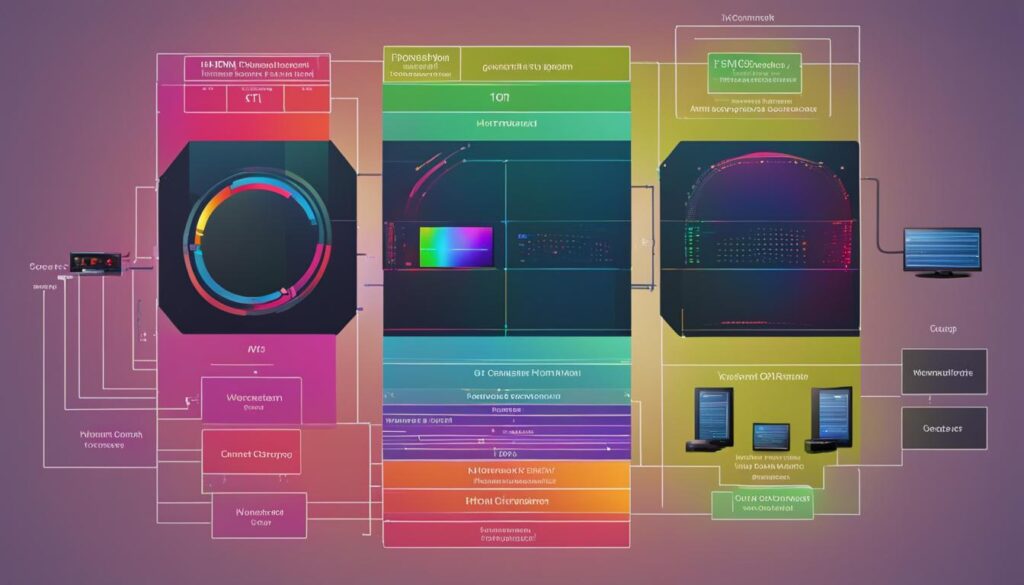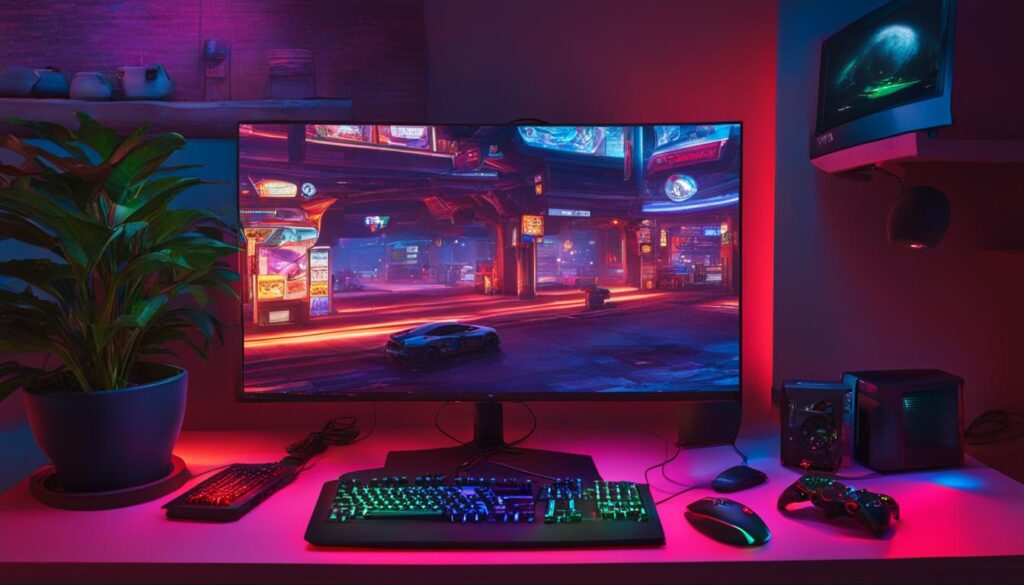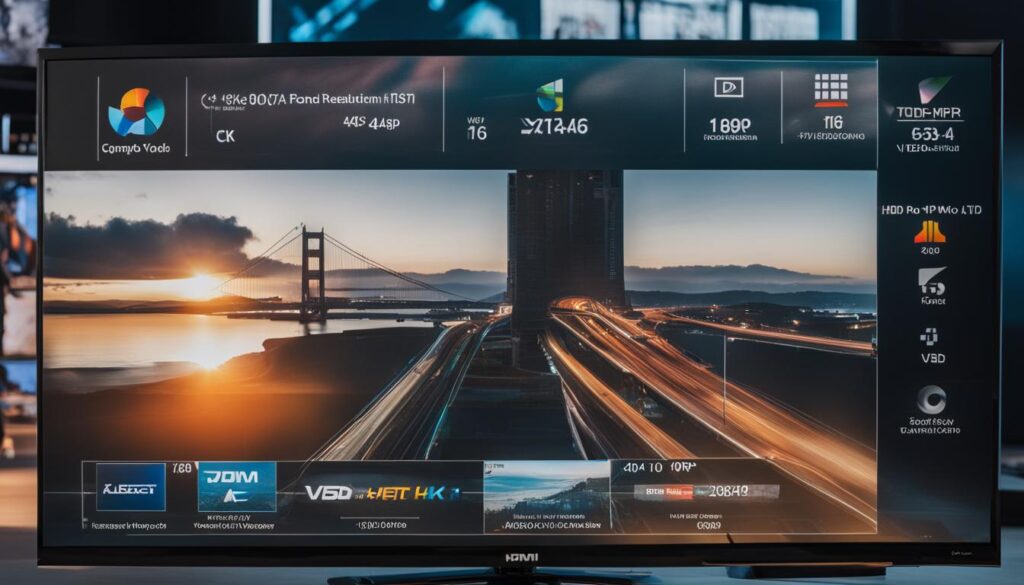You’re trying to connect your modern device with an HDMI output to the familiar interface of a VGA input on your monitor or projector, and there’s a difference in technology – enter the HDMI to VGA cable. This nifty adapter is your bridge between new and old, seamlessly converting the advanced digital signal of the HDMI to the classic analog format used by VGA. Whether you’re presenting a video on a projector or extending your desktop to a second monitor, the HDMI to VGA cable facilitates this connection with ease. However, don’t forget that audio won’t travel through VGA; you may need an additional audio setup to get sound from your videos.
Picture this – your gaming console or streaming device lighting up a vintage computer monitor, your laptop’s presentation material powering through a projector, all without the need for complex installation or configuration. The HDMI to VGA cable has got your back, making signal conversion from digital to analog as simple as plugging in the adapter.
Key Takeaways
- The HDMI to VGA cable enables the connection of HDMI devices to VGA displays.
- It ensures the video signal conversion from digital (HDMI) to analog (VGA).
- While VGA does not carry audio, separate solutions can be implemented for sound.
- This cable is ideal for connecting laptops, consoles, and set-top boxes to older monitors or projectors.
- An additional adapter may be necessary for several configurations due to varied port compatibility.
- Affordable and user-friendly, the HDMI to VGA cable simplifies the tech merge of different eras.
Exploring the Basics: What Is an HDMI to VGA Cable?
Imagine you’ve got an older monitor or a projector that only supports VGA, but your laptop only has HDMI output. This is where an HDMI to VGA cable becomes your essential connector. Simply put, an HDMI to VGA cable is a specialized adapter or converter designed to link devices across these two different formats. By converting the high-definition digital signal from the HDMI output to an analog format compatible with a VGA input, these cables allow you to not just connect, but effectively use your modern devices with older display technology.
Whether you’re using a powerful desktop PC, a portable laptop, or even a media device like a Mac mini, the HDMI to VGA converter adapts the signal from your device’s output port to interface with a display’s input port. It’s the bridge allowing your audio and video to flow from high-definition HDMI-equipped machines to VGA interfaced monitors or projectors that typically expect analog signals.
However, it’s important to bear in mind that VGA ports do not carry audio signals. In these cases, if your presentation or entertainment demands both sound and visual, you’ll need to find an additional solution for the audio, such as external speakers or a sound system with a separate audio input.
- **Check Compatibility**: Always confirm that the converter or adapter you’re considering matches the HDMI and VGA ports on your devices.
- **Understand the Conversion**: Knowing that HDMI sends digital signals and VGA receives analog can help troubleshoot any issues during setup.
- **Audio Arrangements**: As VGA can’t transmit audio, be prepared to set up an external audio connection if required.
Below is a comparative outline that helps delineate the essential characteristics of HDMI and VGA ports to give you a clearer understanding of these two interfaces.
| HDMI Port | VGA Port |
|---|---|
| Carries both audio and video signals | Transmits only video signals |
| Supports high-bandwidth digital content | Designed for lower-resolution analog content |
| Common in modern computers and media devices | Found primarily in older monitors and projectors |
| Provides a clearer, more vibrant image | May offer less sharpness and color fidelity |
In essence, by providing a solution to connect an array of different devices and systems, the HDMI to VGA cable epitomizes technological versatility. Whether you’re presenting from your PC or streaming video from your Mac to an auditorium projector, the converter ensures your content is displayed accurately. All while maintaining the convenience of a single cable, this is the adapter that helps your technology stay connected in a world of ever-evolving video standards. Remember these points when utilizing this integral tool in your tech arsenal.
The Functionality of HDMI to VGA Adapters
When you’re looking to connect your desktop PC, Mac, Chromebook, or gaming console to an older display device, HDMI to VGA adapters are vital for ensuring signal compatibility. VGA, which stands for Video Graphics Array, is an analog interface, while HDMI, or High-Definition Multimedia Interface, provides a high-definition digital signal. HDMI to VGA adapters convert this digital signal to an analog one, allowing your modern devices such as the PlayStation, Xbox, or Nintendo Switch to work with legacy VGA display technology.
How HDMI to VGA Adapters Work
The converters use embedded chipsets to transform the HDMI’s digital signal into an analog signal that VGA inputs can recognize. These adapters are straightforward devices that convert and transmit video content without degrading its quality. Thanks to the precision of the embedded chipsets, HDMI to VGA conversion retains much of the original video clarity, providing resolutions up to 1080p, which is typically the maximum for VGA connections.
The Importance of Embedded Chipsets in Signal Conversion
Embedded chipsets are at the heart of HDMI to VGA adapters, as they are responsible for the conversion process. The chipset functionality is what allows for the digital to analog signal transformation. The sophistication of the chipset determines the video quality and resolution support. A good-quality chipset ensures that the adapter supports the necessary refresh rate and prevents lag that can occur if the conversion is poorly managed.
Maximizing Compatibility with Different Devices
To derive the greatest benefit from your HDMI to VGA adapter, it’s essential to ensure compatibility with the devices you plan to link. Whether you’re looking to connect a laptop to a TV, or your PS5 or Xbox Series X to a VGA monitor, confirming the compatibility of connection ports and supported video standards is crucial for a seamless experience.
- The adapter must match the HDMI output from your source device.
- It should support the VGA input of your display device.
- Consider any additional requirements for audio support, as VGA does not carry audio signals.
A comprehensive table will illustrate the prowess of a quality HDMI to VGA adapter:
| Feature | Functionality |
|---|---|
| Resolution Support | Up to 1080p |
| Chipset Type | Embedded, ensures signal integrity |
| Signal Type Conversion | Digital (HDMI) to Analog (VGA) |
| Device Compatibility | Laptops, TVs, Desktop PCs, Gaming Consoles |
| Refresh Rate Functionality | Support for required refresh rates to prevent video lag |
| Audio Support | Adapter may include separate audio transfer or require alternate arrangement |
Ultimately, a high-quality HDMI to VGA adapter will prove indispensable when you need to bridge the technological divide between new and old electronic devices, ensuring the transfer of crisp, clear video signals from a variety of HDMI-equipped devices to your VGA-based display infrastructure.
Connecting Devices: Making the Most of HDMI to VGA Cables
When it comes to bridging the gap between cutting-edge HDMI-enabled devices and trusted VGA-compatible displays, an HDMI to VGA adapter becomes an indispensable tool in your tech arsenal. To ensure you’re making the most of your adapter, the connection between your HDMI source – like a sleek new laptop or media streaming device – to your reliable VGA monitor or projector must be secure and effective. This is not simply about connecting devices; it’s about achieving seamless integration between different generations of technology.
- Check the Resolution and Refresh Rates: Confirm that the HDMI to VGA cable you’re using can handle the resolution and refresh rate your HDMI devices are outputting.
- Secure the Connection: Ensure that the connections at both ends of the cable are tight and secure to avoid any disruptions in the video signal.
- Audio Solutions: Since VGA does not transmit audio, consider routing your device’s audio output to external speakers or sound system to complement your visuals.

By considering the following detailed insights, you can maximize the functionality of your HDMI to VGA cables, harnessing their full potential without sacrificing the quality of your audio and video signals.
| Connection Aspect | What You Need to Know |
|---|---|
| Resolution Range | Supports standard resolutions up to 1080p |
| Video Adaptation | Converts digital HDMI signal to analog VGA signal |
| Compatibility Check | Adapter should match HDMI output and VGA input standards |
| Audio Arrangement | External audio source required for sound |
Armed with the right adapter, your experience connecting devices with HDMI to VGA cables will be smooth and efficient. Remember, the key to a successful connection is not only about plugging cables but also about matching capabilities and ensuring compatibility between your cherished display unit and the latest technological marvels in your collection.
The Advantages and Limitations of HDMI to VGA Conversion
As technology evolves, so does the need to connect the past with the present. The converter that bridges the gap between HDMI and VGA is a prime example of such innovation. Below, we weigh the pros and cons of employing HDMI to VGA cables—to both revel in their simplicity and understand their restrictions.
Benefits of HDMI to VGA Cable Use
One of the most tangible advantages of HDMI to VGA conversion is the affordability. Consumers can extend the life of their older monitors and projectors without the need to upgrade to newer, often more expensive, HDMI-compatible models. This cable use is particularly advantageous for businesses or educational institutions that may have a considerable stock of VGA-only display equipment.
- Easy Setup: These cables are plug-and-play devices, making the connection process as seamless as possible.
- Resolution Support: Although limited to 1080p, they support high-definition resolutions adequate for most presentations and video content.
- Simple Connection: The integration of devices is straightforward, connecting devices like a laptop or gaming console to a monitor or TV with minimal effort.
Beyond their cost-effectiveness, HDMI to VGA cables embrace the convenience of not requiring additional power sources or software—just connect your modern converter to an older projector or monitor, and you’re ready to go.
Potential Drawbacks to Consider
Despite these perks, there are limitations of HDMI to VGA conversion that necessitate a deeper look. Most prominently, these converters are dealing with an analog signal, which inherently does not offer the high fidelity of a digital transmission. Due to the nature of digital to analog signal conversion, the video output may lack the sharpness and color range compared to a native HDMI connection.
- Resolution Limitations: The 1080p cap means that richer content formats, like 4K videos, can’t be experienced at their fullest potential.
- Converter Latency: There may be a slight delay as the signal converts, impacting fast-paced content like video games or interactive presentations.
- Compatibility Issues: Not all devices work with every converter, and ensuring that your adapter is capable of both TV and computer use is essential.
- No Audio Transmission: VGA does not support audio signals, meaning users will need a separate arrangement for sound.

These potential drawbacks highlight the necessity of assessing your specific needs before purchasing a converter. While ideal for presentations and regular video playback, those with a keen eye for detail and a requirement for the latest video formats may need to explore alternative solutions.
| Aspect | Advantages | Limitations |
|---|---|---|
| Setup | Quick and effortless plug-and-play. | May require additional cables/setup for audio. |
| Resolution | Supports up to 1080p HD video formats. | Does not support higher resolutions like 4K. |
| Compatibility | Works with most HDMI-enabled devices. | May encounter issues with newer technologies (3D, HDR). |
| Affordability | Cost-effective way to use existing VGA displays. | Some quality converters may be more expensive. |
| Audio/Video | Transmits video signals effectively. | Requires separate solutions for audio transfer. |
Considering both the benefits and limitations, HDMI to VGA converters successfully deliver value, especially for those with ample non-HDMI displays who seek to avoid the costs of upgrading. Their simple connection and resolution support make them a pragmatic choice, though mindful of the inherent limitations of an analog signal and its impact on the modern digital world.
Choosing the Right HDMI to VGA Cable for Your Needs
Whether you’re setting up a home theater, gearing up for an immersive gaming session, or preparing for a presentation, choosing the right HDMI to VGA cable is pivotal for a seamless audio-visual experience. Your graphics card, like NVIDIA’s GeForce or AMD’s Radeon, outputs a digital signal that your older monitor or projector’s VGA input was not originally designed to receive. But worry not, as a befitting HDMI to VGA cable can bridge this technological gap. To make an informed decision that tailors to your cable needs, you must consider several factors—compatibility, resolution, and refresh rate play key roles in enhancing your overall experience.
Here’s a handy guide to help you navigate your options:
- Verify Compatibility: Ensuring the cable is compatible with both your device’s graphics card output and your display’s input port is the first step.
- Check Resolution Standards: Match the cable with the highest resolution your display can support. While VGA generally supports up to 1080p, the finer details depend on the individual capabilities of both the cable and the display.
- Consider the Refresh Rate: For a smooth image, especially in gaming, the cable should accommodate the refresh rate your GPU can deliver.
- Assess Build Quality: A well-shielded cable prevents signal degradation, which is vital for clarity and sharpness.
- Look for Added Features: Some HDMI to VGA cables come with integrated audio support, saving you the trouble of managing additional audio cables.
And to help you contrast the options at a glance, consider the following table:
| Feature | Description | Benefit |
|---|---|---|
| Compatibility | Matches GPU outputs like GeForce/Radeon with VGA inputs | Ensures your devices can connect without issue |
| Resolution | Supports up to 1080p display standards | Guarantees the cable can deliver high-definition video quality |
| Refresh Rate | Compatible with the GPU’s fps output | Synchronous display and smooth motion, especially in gaming scenarios |
| Audio Support | Some cables come with a 3.5mm audio jack | Convenient for connecting external speakers directly |
| Build Quality | Durable materials and shielding | Reduced interference and prolonged cable lifespan |
Remember, the cable is an extension of your gaming or viewing experience. So whether you’re using a high-end GPU for gaming or a standard graphics card for business presentations, choosing an HDMI to VGA cable that meets your specific needs is essential. With the right cable, you can turn a compatible media setup into a display powerhouse, perfectly synching your GeForce or Radeon capabilities with your display unit for a mesmerizing experience.

Enhancing Your Viewing Experience: Resolution, Aspect Ratio, and Refresh Rate
When you’re keen on enhancing your viewing experience, understanding the interplay between digital and analog signals is crucial. Digital signals, known for their high fidelity, maintain video quality as they transmit discrete values, making them resistant to degradation over distances. On the other hand, analog signals, though once standard, are susceptible to loss in quality due to their continuous nature, especially when converted from digital sources. This is where the role of an HDMI to VGA adapter becomes prominent, serving as a vessel for signal conversion to allow interoperability between devices with HDMI and VGA ports.
The Role of Digital and Analog Signals in Video Quality
The conversion from digital signals to analog signals via an HDMI VGA cable requires precision to preserve video quality. HDMI, with its higher bandwidth, offers a crisp, vibrant display, enhancing your media consumption with stunning visuals. However, VGA analog signals, due to their inherent limitations in resolution, have a reduced color depth and clarity. Yet, a well-executed digital conversion process can still culminate in a quality viewing experience on a VGA display, despite these technical disparities.
The aspect ratio and refresh rate also influence the perception of video quality, particularly when connecting a PC to a monitor. A mismatch in these standards can result in stretched images or less than smooth gameplay and video playback. It’s paramount that these parameters are well-synced to ensure a seamless viewing experience.
Understanding the Impact of Display Standards on Your Media
Display standards like aspect ratio, display size, resolution, and refresh rate guide the overall performance of your media devices. When connecting devices, the impact of display standards cannot be dismissed, as these parameters define how content is rendered on your screen. Using an HDMI VGA adapter to connect a laptop to a TV for example, is not just about establishing a bridge between the devices, it’s about ensuring the content you view is optimally displayed according to these standardized metrics.
Below is a table that contrasts the capabilities of HDMI and VGA signals and the impact they could have on your viewing experience:
| Feature | HDMI (Digital) | VGA (Analog) | Impact on Viewing Experience |
|---|---|---|---|
| Resolution | Up to 4K UHD | Up to 1080p HD | Higher resolutions available with HDMI lead to a more detailed and immersive picture. |
| Aspect Ratio | 16:9 (Widescreen) | 4:3 (Standard) | Modern widescreen formats on HDMI may not translate well to the traditional aspect ratio of VGA. |
| Color Depth | Rich and Deep Colors | Limited Color Range | HDMI provides a more dynamic color palette, adding vibrancy to your displayed media. |
| Refresh Rate | Up to 120Hz and beyond | Typically up to 60Hz | A higher refresh rate with HDMI results in smoother motion, critical for fast-paced content. |
As you navigate the world of display standards, remember that the right HDMI VGA cable can significantly enhance your overall viewing pleasure, especially as it facilitates the transition from modern digital outputs to the enduring analog inputs. Aligning your display size, resolution, and refresh rate to suit your content needs, while considering these aspects, will ensure that your media truly shines on your chosen display device.

- For a superior viewing experience, consider devices and adapters supporting high-definition resolutions.
- Maintain the native aspect ratio of your content, whether it’s for gaming or movie watching, to avoid distortions.
- Ensure your refresh rate is high enough to keep up with fast-paced games and movies, reducing motion blur and enhancing clarity.
The quintessence of great video playback lies in the sweet spot where technology meets consumer expectations. By understanding and leveraging the strengths of both digital and analog signals, you can significantly elevate your media moments, whether they’re personal entertainment sessions or grand visual presentations.
Embracing Modern Connectivity: Transitioning from VGA to HDMI and Beyond
As you keep pace with the fast-evolving world of technology, embracing modern connectivity is key. The shift from the legacy VGA interface to the more sophisticated HDMI reflects a significant technological leap. By transitioning from VGA to HDMI, you unlock the potential for higher video quality, ensuring richer and more vibrant visual content. Today, modern interfaces such as DVI and DisplayPort have been developed to fully harness the capabilities of digital signals, offering greater bandwidth and enhanced features compared to their analog counterparts.
Wireless streaming has revolutionized the way we think about connecting devices, offering a clutter-free alternative to cable connections. With options to stream content to HDMI-compliant devices, your setup can be both sleek and efficient. Furthermore, the DisplayPort interface, which is royalty-free, presents an appealing choice for manufacturers and consumers alike, eliminating the extra cost associated with royalty fees and simplifying the adoption of modern connectivity solutions.
Whether your focus is on productivity, entertainment, or digital artistry, transitioning to a modern interface is an investment in the quality and flexibility of your tech ecosystem. Adaptors and cables like HDMI to VGA have played their part in bridging the gap between old and new, but as you move forward, consider integrating interfaces like DVI, DisplayPort, and wireless streaming solutions into your setup to keep up with the digital signal age without being tethered by royalties. DisplayPort’s royalty-free advantage only adds to the appeal, casting it as a frontrunner in the modern connectivity realm.
